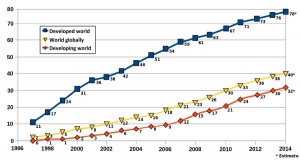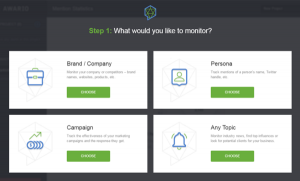Are you looking for better ways to get links to your e-commerce site?
Sixty-one percent of internet users research products online before making a purchase. Seventy percent of those people are clicking on search engine results instead of paid links. (Source)
In the past couple of years link building has been a cause for concern. Most of us have heard the horror stories of companies losing rankings (and profits) from bad link building practices. With this in mind, let’s start with old-school methods of link building you should now avoid.
Link building practices to avoid
If Google has made one thing very clear over the past two years, it is that they don’t like it when people try to cheat their system! If someone searches for “best power strips” and gets a bunch of low quality pages filled with ads, they are more likely to leave Google and go to another search engine.
This is why Google Penguin and Panda were created. They were built to reduce the ranking of low-quality content sites and punish those sites that use link building practices that are against Google Webmaster guidelines.
Some examples of link building practices to avoid include:
- Having too many link exchanges (i.e. if you link to me, I’ll link back.)
- Buying or selling links that pass PageRank (this includes advertorials, text advertisements, and native advertising)
- Using any type of automated service or software to create links for your site
- Article marketing campaigns that create keyword-rich anchor text links
- Links coming from low-quality directories and bookmark sites
To get the full list, go to Google’s page on link schemes in Webmaster Tools.
Building Links (that won’t get you in trouble)
Attracting links using great content
“Companies that blog have 97% more inbound links.” (Source)
It is possible to attract links to your e-commerce site, but it doesn’t happen very often. You’ll have better luck and generate more links by having high-quality content on a blog that people enjoy reading. The key here is to know your audience and understand how the products you sell can help them.
Make your content about your visitor and share with them how you’re going to solve their problems. Along the way, you can mention products that might help them.
The goal is to generate content that is so helpful that people are willing to share it with their friends. Copying (or rewriting) the same content that is available at every other site is not going to garner many backlinks.
By now you’re probably thinking, “That’s great, but how do I know what content is likely to be shared?”
One solution is to use a tool like buzzsumo.com to find content ideas that are frequently shared.
Let’s say for example, you have an e-commerce site where you sell innovative power solutions. You know, the kind of power strips that meet special needs for people with big power bricks that never seem to have enough space on traditional power strips.
You could then go to buzzsumo.com and type in the phrase “power strip”. It will return webpages that are frequently shared with the topic “power strips”. This is content that you already know people have an interest in because they are sharing it with other users.

In the example above, the top selection happens to be a short article with an image about power strip organization ideas. You can see it’s had 11,797 Pinterest shares as well as 17 shares on Facebook (as well as a few others). Since you already own an e-commerce site that sells advanced power strip solutions, you probably know more about the topic than most people. All you need to do is write (or have written) a better article and publish it to your blog.
After that, you will use your social media accounts to raise awareness about your new high-quality post that people will want to share. If you have an email list, share this new content with them as well.
Suppliers or Manufacturer’s Resource Pages
Resource pages can be a good source of backlinks as long as they are relevant to your niche. To find these pages, you can use the following Google search:
intitle:resources “power strips” (“retailer” OR “manufacturer” OR “supplier”)
This type of search will take some time, but the backlinks are worth the effort. You will need to filter out poorly designed, irrelevant, or low domain authority sites.
If you have several categories on your e-commerce site (maybe you sell home power strips as well as the larger rack mount server room solutions), you can search for different types of power strips to find more suppliers.
Once you find a list of suppliers, you will need to contact each one using email to ask for a backlink.
Forum Threads
“Forum marketing has always been one of the effective forms of link building, even after Penguin took its position in the search game. Its ability to drive relevant and targeted visitors to a website is one of its strengths and the reason why webmasters and bloggers are still investing in it,” according to Venchito with searchenginejournal.com.
You can find relevant forums using the Google search (intitle:forum “power strips”). You will want to find a forum that has strict editorial guidelines which are closely monitored by moderators. These forums will already be ranking in Google for your keywords.
Once you find the best forums:
- Find participants that are active in the community, based on their number of daily and weekly posts. Reach out to them on the forum as well as by email and other social networks.
- “Become the first one to answer questions that you know you can answer really well based on your experience and expertise (it is also very important to identify the best time people are engaging on the site),” says Venchito. Include your backlink in the signature that will be at the bottom of each post.
Associations and clubs
Regardless of your niche, there are likely to be clubs and associations that you can join. Before joining, take a look at the backlinks they are providing to other sites. If they have hundreds of backlinks to other e-commerce sites and nothing else, you may want to move on.
Your backlink action plan
- Document your current rankings using a tool like SemRush or CuteRank.
- If you think your rankings have dropped due to a recent Penguin update, you can learn more about Penguin 3.0 update.
- Create new pieces of content based on how big brands are getting it right. You may also go with ideas found using BuzzSumo.
- For each new piece of content, post 2-3 tweets per day at times when your followers are most active.
- Create a post on each one of your other social media sites (make each post unique).
- Start an outreach program to contact a few vendors each week and ask if your company can be added to their resource page.
- Start participating in relevant Be the first to post answers to problems you know you can solve. (This is not the place to promote your products!)
- Join relevant associations and clubs.
Digital & Social Articles on Business 2 Community
(361)






